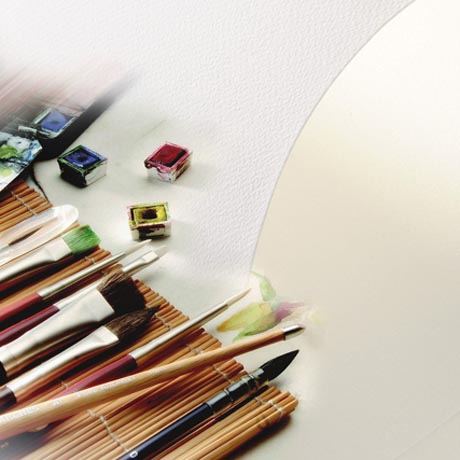In order to have your material ready for use and to keep it in good shape over the long run, you need to make sure to clean and maintain it. Watercolor is a practical technique that cleans up easily: all you need is some soap and water!

1. Paintbrushes
While watercolor as a medium is less hard on paintbrushes than oils and acrylics, you do need to meticulously clean everything every time after you paint.
5 steps to clean brushes:
- Start by rinsing the bristles of your paintbrush in a container of clean water.
- Remove the extra water from the brush bristles, snapping your wrist to shake it hard.
- Gently smooth the bristles between your thumb and index finger to get all the bristles back in place.
- If you have some color on your fingers after smoothing the bristles (some pigments, such as alizarin, are hard to rinse), it means your brush isn't clean! You can use artist’s soap (or just plain soap): moisten your brush, put soap on the bristles, work it into a lather in the palm of your hand to get the soap to penetrate all the way to the heel at the base of the ferrule, then rinse under running water.
- Dry your brushes lying flat, on absorbent paper or an old hand towel. Once dry, store in a paintbrush container with the bristle end up.
Remember: don't dry your paintbrushes upright, because water will seep into the ferrule. As a result, the moisture will swell the wood handle and spread the bristles. The brush will lose its shape and the fineness of its stroke!
Tip
An old hand towel can be useful for keeping dust off your brushes, and for carrying them around, carefully rolled inside.
2. Colors
Watercolor paints in cakes or tubes will keep a long time and need little care.
- Tubes: make sure to screw the cap back on completely after each use, so the tube is hermetically closed.
- Watercolor cakes tend to dry out and crack over time. To keep this from happening as fast, store them away from air in a wood or metal box.
Remember: are there a few specks of mold on your cakes of paint? No problem! Simply clean them with some water and absorbent paper or the corner of a rag.

3. Palette
Rinse your palette under clear water as soon as you're done painting: the less time the paint has to dry, the easier it will be to clean it up.
- Use a little sponge or a piece of rag to remove any paint stuck in the compartments.
- Are there spots that won't come off? A little household soap or dishwashing detergent will get rid of them for you!
- Dry your palette with a rag or absorbent paper.
Recommended product:
Montval®
See also :
Watercolour
Selecting your watercolor paper
